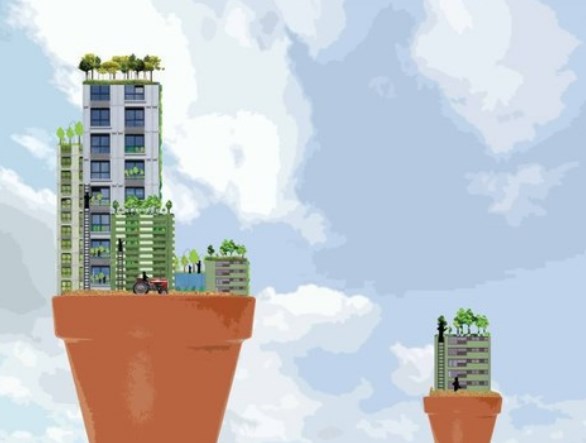Instead of destroying the ecosystem, is not it better to create them? Возьмите, for example, shine, это природный ресурс. Люди любят работать и жить в окружении естественного света. А ведь используя современные решения в строительстве можно намного лучше использовать естественный свет. Или возьмите, eg, vertical gardens. Вертикальные сады позволяют превратить наши города в устойчивые городские хозяйства, in which crops sprout on buildings and their interiors.
The population on the move
The world's population is concentrated in cities. Eighty percent of the 9 billion people, valued at 2050 year, probably, will live in urban areas. Many of our cities are experiencing social and environmental problems, which are the result of such pressure as the:
- overpopulation,
- poverty,
- pollution or traffic.
The growth trend for living in urban areas will continue. All cities in the world occupy only 2% Earth's surface, but they are home to half the world's population, in Europe 75% , expected, what to 2020 , this percentage will increase to 80%. Сегодня европейские города потребляют 69% энергии и, Consequently, They are central to the emission of greenhouse gases. The environmental impact of cities are huge figures, eg, при анализе Лондона было подсчитано, that its ecological footprint in 300 times its area. Urban pollution is often also affect the non-urban areas.
Changing of the climate – new and ominous phenomenon, which casts a shadow on life in the city. This could aggravate social inequality: the poor are often more vulnerable and do not have the resources to adapt. Climate change will also affect the urban environment: on air and water quality.
From adaptation to new thinking
Our cities and urban areas suffer from many problems, from the social and health to environmental. However, the proximity of people, businesses and services, closely associated with the concept of "city", also it offers great opportunities.
The urban environment offers a valuable opportunity for viable life. The population density in cities increases the number of jobs and services, growing and use of public transport and small apartments, requiring less lighting and heating. As a result, city dwellers consume less energy per capita, than rural dwellers. Our cities are also in special situations, when it comes to mitigating and adapting to climate change. physical properties, design, Control and location of the city – these are just some of the factors, which can help to cope with both these phenomena.
Of course, modern building approaches, такие наводнения как «зеленое» строительство, which is already widely used in Ukraine, you can see an example of new buildings LCD Greenville Park in Podil, this is only part of the solution. Adaptation to climate change also requires in-depth reflection and project management in urban areas and should be taken into account in all relevant policies, including land use, housing, water, transport, energy, social justice and health.
By changing the way we think about the concept of the city, its architecture, transport and planning, our cities and urban landscapes can be transformed in urban ecosystems, which come to the fore in mitigating climate change (ecological transport, clean energy) and adaptation (floating house, vertical gardens). Improving urban planning will improve the quality of all aspects of life and create new opportunities for employment, encouraging the market to use the new technologies and green architecture.
When urban planning is essential to ensure lower energy consumption per person, using such resources, as public transport or energy efficient construction. New technologies, promote energy efficiency and use of renewable resources, including wind and solar energy, as well as alternative fuels, also important, because they provide individuals and organizations with an opportunity to change their current impact on the ecological environment.













